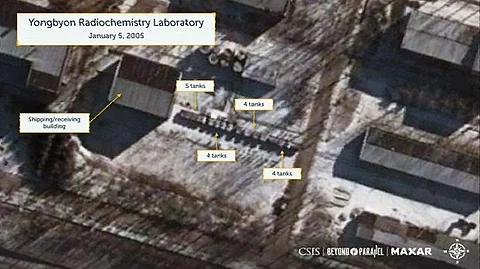
- Home
- न्यूजग्राम
- NewsGram USA
- India
- World
- Politics
- Entertainment
- Culture
- Lifestyle
- Economy
- Sports
- Sp. Coverage
- Misc.
- NewsGram Exclusive
- Jobs / Internships

A new report strongly suggests that a chemical plant in northern North Korea is the main supplier for the country’s nuclear program.
RFA
A new report strongly suggests that a chemical plant in northern North Korea is the main supplier for the country’s nuclear program, citing satellite evidence that appears to show shipments of chemicals from the plant to the Yongbyon nuclear facility.
Beyond Parallel, a project of the Washington-based Center for Strategic International Studies, or CSIS, said that the Manpo Unha Chemical Factory manufactures chemicals including nitric acid, necessary for the processes that produce Plutonium-239 from spent nuclear fuel rods – used in nuclear weapons production – and uranium hexaflouride – used to make highly enriched uranium, needed for nuclear power generation or nuclear weapons.
The report analyzed 514 satellite images that showed specialized chemical transport rail cars both at the plant, located near the city of Manpo on North Korea’s border with China, and at the Yongbyon nuclear facility about 155 kilometers (96 miles) to the southwest, highly suggesting that the chemicals made at the plant are transported to Yongbyon.
“This imagery analysis combined with interview data strongly supports the assessment that the Manpo Unha Factory is the source of the specialized rail tank cars observed at the Yongbyon Nuclear Research Center and that the factory is linked to North Korea’s nuclear program,” the report said.
The chemical plant appears to have been operational since 1975 and it has been suspected of having a connection to Yongbyon and supporting the North Korean nuclear program since the mid 1970’s
The report said the specialized rail cars likely began to transport chemicals from Manpo to Yongbyon as early as the 1980s. However, this could not be confirmed because satellite imagery from the years 1985-2000 remains classified.
Commercial satellite imagery became available in the early 2000s, and since then the rail cars were seen 95 times at both locations, and as recently as March 17, 2023.
Helpful for future negotiations
If the relationship between Manpo and Yongbyon is eventually proven, it could have implications for potential denuclearization negotiations with Pyongyang, the report said.
“As the prime provider of chemicals to the Yongbyon Nuclear Research Center, the Manpo Unha Factory would presumably have to be subject to declaration, verification, and dismantlement in any future final and fully verifiable denuclearization deal with North Korea,” it said.
The Manpo chemical plant has been of interest to North Korea watchers and observers interested in weapons of mass destruction for a long while, according to Jacob Bogle, curator of the AccessDPRK website which analyzes North Korea through satellite imagery.
“It has traditionally been known as a center of production for North Korea's chemical weapons program, but the CSIS/Beyond Parallel report does a very good job linking Manpo with North Korea's nuclear and ballistic missile programs as well,” Bogle told Radio Free Asia’s Korean Service.
Bogle said that understanding the North Korean nuclear weapons supply and production chains would enable the international community to confront Pyongyang over its activities and lay out plans for declaration, verification and disarmament.
“The requirements for chemicals like nitric acid, needed to produce uranium hexafluoride, will only increase as Kim Jong Un places a greater priority on enlarging the country's nuclear arsenal,” he said. “So Manpo's importance to the country's nuclear infrastructure will only grow in time.”RFA
The report’s findings all but establish that the Manpo chemical plant is part of North Korea’s nuclear program, Cheong Seong-chang, a researcher at the South Korea-based Sejong Institute, told Radio Free Asia’s Korean Service.
“There’s a good chance that the Manpo Unha factory and the Yongbyon nuclear facility are connected,” said Cheong. “The munitions industry is also concentrated in Kanggye, Chagang Province, which is close to Manpo."
In addition to manufacturing chemicals used in processes for the nuclear program, the Manpo plant is also believed to be the source for liquid rocket fuel production, chemical weapons research and production, and industrial uses, according to the report. (NS/RFA)
